| 1: Gameplay |
|
 |
Victory |
|
|
 |
The Law of Fudge |
|
 |
What I Say Goes |
|
|
|
 |
Critical Rolls |
|
|
 |
Things You'll Need |
|
 |
Things You Probably Won't
Need But Might Want Anyway |
|
|
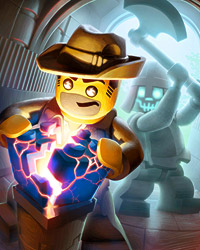
In a forgotten shrine to Pandora's Blox, tomb-raiding archaeologist Solo Jones prepares to crack open the mysterious secrets of ABS, the Alogical Binding Substance - but some blocks are better left untouched.
Unsophisticated players
might think that the Letter of the rules is more important
than the Spirit - but the Letter isn't liable to sneak
up behind you with an axe if you abuse it. |
| "Esprit de
Core," 2005 |
|
Chapter One: Gameplay
The purpose of BrikWars is to provide a safe and comfortable setting
in which groups of cute and friendly minifigs can mutilate and slaughter
one another. The battle can be large or small, balanced or skewed,
ordered or chaotic; what’s important is that the level of mindless
violence is kept at an entertaining high.
1.1: Overview of Play
 |
| "If our most highly qualified
General Staff officers had been told to work out
the most nonsensical high level organization for
war which they could think of, they could not
have produced anything more stupid that that which
we have at present. " |
| - Claus von Stauffenberg |
|
|
 |
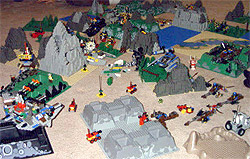
| Raised baseplates and
brick mountains scattered around the floor make a perfectly
decent battlefield. |
Photo: Pete Callaway
STUDS's "Battle of Tank Stream," June 2000
Winners: SHAG |
|
Players prepare for the game by building armies, fortifications, and
battlefield landscaping out of plastic construction bricks (or whatever’s
most convenient). They have the option of imposing a military budget
of Construction Points on each side if they suffer from the notion that
armies should be equal and battles should be "fair." Players
might spend hours carefully crafting the look and equipment of each
soldier and vehicle, or they might just grab mismatched units at random
out of a bin. It’s left to the players to decide how serious
they want to be.
When the battlefield and armies are assembled, players can pick their
starting locations by any combination of mutual agreement and dice-rolling.
If one player designed the battlefield, it’s customary to allow
the other players to have first pick of starting locations, to prevent
unfair advantage. Sometimes the armies' starting locations will be
dictated by the scenario - in a castle siege, for instance, the defenders
are arranged inside and around the castle and the besieging force
begins at whichever edges of the battlefield seem most advantageous.
Once the armies are in place, the battle can begin. Each player takes
a turn maneuvering forces and making attacks for all of the units
under his control, before passing play to the next player. When all
players have taken their turns, the cycle begins again with the first
player and continues until one side "wins."
Victory
 |
| "It's never 'just a game'
when you're winning." |
| - George Carlin |
|
|
 |
An army wins a battle by achieving its Objective. An army's
default Objective is "the destruction and humiliation of all
other armies," but more complex or specific Objectives are possible,
such as "assassinate the enemy leader" or "collect
the largest pile of severed heads."
As a general rule, it's not entirely common for any one player or
team to "win" a battle. This is because getting killed horribly
in some ridiculous fashion is always funnier than the alternative
(i.e., surviving horribly in some ridiculous fashion), and BrikWars
is set up to favor the optimum result of a complete massacre of all
participants, along with any bystanders and scenery. You should expect
your BrikWars battles to often end with the final victory going to
a force of nature or some deadly location rather than to any player.
'Fire,' 'explosive decompression,' and 'nuclear fission' have winning
records that no human strategist can hope to match.
The 'classik' conclusion for a BrikWars battle is for the entire battlefield
to be destroyed in a cataclysmic fireball. This is considered a victory
for all sides except those whose Objective was to prevent destruction
(e.g., "protect the doughnut factory").
1.2: Proper Observance of Rules
 |
| "The more laws and
order are made prominent, the more thieves and robbers
there will be." |
| - Lao Tzu |
|
|
 |
 |
| "The secret we should
never let the gamemasters know is that they don't
need any rules." |
| - Gary Gygax |
|
|
 |
 Rules are for the small-minded and weak. Let a little kid loose among
your collection of bricks sometime, and watch the way he plays. In
his hands, those minifigs will have all kinds of crazy battles and
adventures, there'll be all the drama, death, and explosions you could
ever want, and the whole time that kid won't have to crack open a rulebook even once. How is it that he's so much smarter than we are?
The answer is that most of us have had a lot more years of schooling
than he has. Wait until he's eighteen, he'll have become just as slack-jawed
and dull-eyed as the rest of us. Rules are for the small-minded and weak. Let a little kid loose among
your collection of bricks sometime, and watch the way he plays. In
his hands, those minifigs will have all kinds of crazy battles and
adventures, there'll be all the drama, death, and explosions you could
ever want, and the whole time that kid won't have to crack open a rulebook even once. How is it that he's so much smarter than we are?
The answer is that most of us have had a lot more years of schooling
than he has. Wait until he's eighteen, he'll have become just as slack-jawed
and dull-eyed as the rest of us.
BrikWars has a lot of rules. If the mandatory education system has
had the chance to get its hooks in you, then you'll respect the authority
of those rules, because they're all written down in a book, and some
of them are capitalized. If things went so badly that you ended up
going to college as well, then you'll probably not only shackle yourself
to those rules but also then try to lovingly twist them to your own
ends, weaseling out loopholes and exploits to cleverly frustrate the
other players and ingeniously prevent fun for the entire group.
If you find yourself engaging in that kind of rules-lawyering and
munchkinism, then you have just failed at BrikWars. Stamp a big F
on your report card, schedule a get-together between your face and
the Hammer of Discipline, and see if you can't spend a little time
afterwards with a couple of five-year-olds to remember the things
you've forgotten about having fun.
The reason BrikWars has so many rules is that it's a lot more fun
to flout a large rules system than a small one. Hopefully you can
use these rules as a springboard for the imagination rather than as
manacles with which to enslave yourself. However, we also recognize
that not everyone is ready to live without the safety net that a system
of rules provides, especially while in competition with others. So,
before we go any further, here are the two most important rules in
the book.
THE LAW OF FUDGE

Fudge
everything your opponents
will let you get away with. |
| "Hell, there are no
rules here - we're trying to accomplish something." |
| - Thomas Edison |
|
|
|
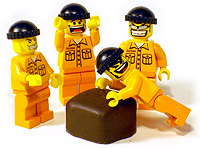
| The power of fudge overrides
all laws. |
| Elements shown:
LEGO, fudge |
|
BrikWars provides chapters and chapters full of rules to calculate
events down to the tiniest detail. If a player tries to follow all
of them to the letter, their turns will take hours, everyone will
lose interest, and no one will want to play a second time. This is
for the best. Those people should stop trying to play with construction
bricks and instead give them to someone with an imagination.
Just because you can assign die rolls to every sneeze and determine
landing trajectories for every blown-off body part, doesn't mean you
should. The most probable results are very often the least ridiculous,
and why bust out the calculators only to spend more time having less
fun? Except where your opponents insist otherwise, you should resolve
the bulk of your actions with rough estimates, arbitrary decisions,
and an abundance of vague hand-waving. Given the opportunity, always
fudge in favor of mayhem.
Don't waste time on stuff nobody cares about. Following the rules
and winning are the two lowest priorities on your list. Getting some
good laughs during the battle and having a good story to
tell afterwards are your primary goals.
WHAT I SAY GOES

Players
are smarter than rulebooks. Especially the ones with the
highest dice rolls. |
| "Any commander who
fails to exceed his authority is not of much
use to his subordinates." |
| - Arleigh Burke |
|
|
|
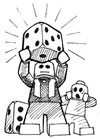
| Large dice are better than small ones in
a What I Say Goes Roll, if you have enough to go around - more
sides means less chance of a tie between players. |
|
There
will be many times when players will have a difference of opinion,
when the best course of action isn't clear, or when no one remembers
the details of a rule but they don't care enough to waste time looking
it up. “Can a zombie bite convert dogs into zombie dogs?”
“Can that archer really fire at the petting zoo from where he’s
hiding?” “Is that hot dog stand really within bazooka range?”
If players can’t come to a quick consensus, then it’s time
for a What I Say Goes Roll. All interested players (and, in some cases, sufficiently opinionated bystanders) state
their position. All participating players roll dice, re-rolling
ties if necessary. The player with the highest roll wins, and What
He Says Goes – as long as he said it before rolling the dice!
There's no changing your position once the dice are cast.
 |
If one player takes a position that’s an obvious
and deliberate attempt to cheat, his opponents are obligated to beat
the crap out of him. The player should then revise his position, although
you might let him get away with keeping it if the beating
was good enough. |
 |
The first What I Say Goes Roll in most games is to decide the order
of play. The winner decides who goes first and in what order the players
will take their turns.
1.3: Taking Measurements
 In BrikWars, distances are measured in inches. If you don't like inches,
you can use any alternate system of measurement that seems reasonable
- an inch is about three centimeters, the length of three surface
studs, or the height of three construction bricks. It's not important
whether or not your conversion is exact, as long as everyone's using
the same system. In BrikWars, distances are measured in inches. If you don't like inches,
you can use any alternate system of measurement that seems reasonable
- an inch is about three centimeters, the length of three surface
studs, or the height of three construction bricks. It's not important
whether or not your conversion is exact, as long as everyone's using
the same system.
As with most aspects of BrikWars, flexibility is key: bendable measuring
tape is going to be a lot more useful than a rigid ruler, since you'll
often want to measure around corners or in tight spaces. If you haven't
got a measuring tape handy, a simple ribbon or piece of string marked
off in inches is just as good.
1.4: Rolling Dice
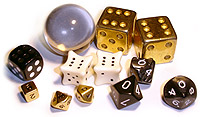
An assortment of d6es,
d10s, and one glass d0. You will almost certainly never
need a d0 in BrikWars.
The result of this unusually lucky roll is 0 + 6 + 6 +
6 + 6 + 6 + 6 + 10 + 10 + 10 + 10 + 10, or 86, ignoring
the possibility of Bonus Dice.
It's unclear whether or
not a roll of 0 on a d0 counts as a Critical Success. |
| Elements shown:
dice |
|
 |
| "Jacta alea est.” |
| - Julius Caesar |
|
|
 |
BrikWars uses dice to add an element of randomness into the game.
If a minifig fires a rifle at an opponent, sometimes he'll hit and
sometimes he'll miss; if the enemy minifig is struck by the bullet,
he might survive the damage, or he might not. Die rolls determine
the outcome of actions whose success isn't guaranteed.
For most of the Core Rules, dice come in two flavors: the d6 and the d10, named according to how many faces are on each die. The
six-sided d6es ("dee-sixes") are regular cube-shaped
dice, much like you might find from raiding any board game, except
that when you call them d6es it sounds 1d100 times as geeky. The ten-sided
d10s ("dee-tens") are a little more unusual; you'll
have to do some shopping at your local gaming store or website to
stock up. The d6es are used for almost all normal action in BrikWars,
while d10s are reserved for certain types of high-powered combat.
 |
If you don't have any ten-sided dice, you
can replace any d10 roll with 2d6-2 - that is, roll two six-sided
dice and subtract two from the result. Is this statistically
equivalent? Not really. Do we care? Refer to The Law of Fudge,
above. |
 |
In BrikWars and most other wargames, die rolls are described according
to the number of dice involved, plus or minus a modifier (if any). 4d6 means a roll of four six-sided dice, all added together; 1d10+2 means you roll one ten-sided die and add two to the
result. 17d6+23d10+0937 means rolling seventeen six-sided dice
and twenty-three ten-sided dice together, and adding nine hundred
thirty-seven to the result, which you will hopefully never have to
do.
 |
Some people like to refer to dice with a
"die-" rather than a "dee-" prefix. But how,
then, does one refer to dice in multiples? With the utilitarian "die-sixes,"
or the more erudite "dice-six?" The solution is this:
whenever someone refers to a die-anything, kick them in whichever
shin is most convenient. This will forestall any arguments about proper nomenclature
and pluralization. |
 |
No matter how negative a modifier may be, the lowest possible result
for any die roll is zero. A roll of 1d6-100 will almost always
have a simple result of zero, for instance, unless a player's luck
with Critical Rolls defies belief.
Critical Rolls
Rolling dice in BrikWars is never a sure thing. No matter how easy
or difficult the task, there’s always at least a tiny chance
of failure or success, thanks to a couple of special cases when rolling
dice.
 |
Critical Failure
If all the dice in any roll come up ‘1,’ then the
roll is a Critical Failure. Whatever task a player or unit was
attempting fails completely, no matter how easy it might have
been. |
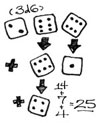 |
Critical Success
Luckily, rolls can also turn out unexpectedly well. When rolling
any number of dice, for each die that comes up on its highest-numbered
face (a six on a d6, a ten on a d10), the player may add +1d6
to that roll as a Bonus Die. The same holds true for
the additional dice rolled – any sixes rolled on the Bonus
Dice continue earning additional Bonus Dice. A player may elect
not to roll a Bonus Die that he’s earned, for whatever
reason. |
1.5: Supplies Checklist
 |
| "The very existence
of flamethrowers proves that some time, somewhere,
someone said to themselves, 'You know, I want to
set those people over there on fire, but I'm just
not close enough to get the job done.'” |
| - George Carlin |
|
|
 |
Besides the obvious items like armies, a battlefield, and other players,
you should make sure you have the following.
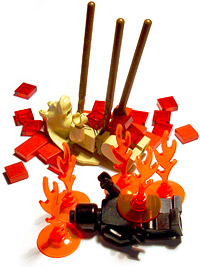
| Jaw-Jaws and Dimmies
are great for demonstrating the use of blood and fire
elements. |
| Elements shown:
LEGO |
|
Things You'll Need
 |
 |
Fun
First and most importantly: fun. It seems obvious,
but this item is so often bizarrely forgotten by all types
of gamers (especially wargamers) that it bears repeating: don't play a game
if you don't mean to have fun. And for the love of
God make sure you bring enough to share, because it's
not all about you. |
|
 |
 |
 |
Dice
You'll need a good supply of dice - the more, the better.
Most of the Core Rules are written entirely for two types of dice
- regular six-sided dice (d6) for regular units, and the
more unusual ten-sided dice (d10) for siege- and hero-level
units. (Starting in Chapter Seven, rules are given for using a greater variety of exotic dice, but these are entirely optional.) |
|
 |
 |
 |
Stat Cards
Even if you think you've got all your units' stats memorized,
it's good to keep their stat cards handy, if for no other
reason than to reassure your opponents that you're not
making up numbers off the top of your head. (Not that there's anything wrong with that.) |
|
 |
 |
 |
Blood and Fire
While not completely necessary, it really adds to the
ambience if you have a healthy supply of little red plates and
flame elements to scatter around whenever it seems like
the battlefield could use more blood or more fire. And
seriously, when could a battlefield not use more blood
and more fire? |
|
 |
 |
 |
Spare Parts
Not a requirement, but it's often nice to be able
to whip up a costume change for your hero, a crater and
random debris from an explosion, a stand to hold up a
minifig in a precarious position, or any number of other
objects that might appear as the result of unexpected
events. |
|
 |
 |
 |
Cameras
By nature, BrikWars games are full of amazing constructions,
crazy action scenes, and hilarious mishaps that you'll
wish you had photos of afterwards. Most impressive of
all to fellow gamers, as verified by ten years of fan
mail, are the astonishing photos that show BrikWars being played by real live girls. |
|
 |
 |
 |
Doughnuts and Beer
Pizza, chips, and Mountain Dew are the more traditional
food of wargamers, but the proper BrikWars mindset is
less about "Gary Gygax" and more about "Homer
Simpson." Cheeseburgers are an acceptable compromise. |
|
 |
Things You Probably Won't Need But Might
Want Anyway
If you're not making up bizarre and crazy ad hoc rules on the fly,
you're not really playing BrikWars. As such, you might want to bring
extra gear just on the off chance that you think of funny things to
do with it.
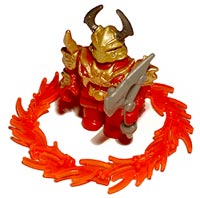
| Fire Rings have no purpose
in BrikWars except to intimidate newbies. If asked why
you brought a bag of Fire Rings, say "Just in case
we need them for some of the really advanced rules." |
| Elements
shown: LEGO, Mega Bloks |
|
 |
 |
Pencil and Paper
In case you want to pass love notes to the cute player
on the other team. Otherwise, not really necessary. |
|
 |
 |
 |
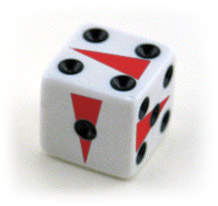 Funny
Dice Funny
Dice
Nothing says gaming like funny dice. A Stumble die, for
instance, is easily made by taking a Sharpee and dashing
off a quick arrow on each face of a regular d6; now with
every roll you get both a direction and a number of inches.
Good for ad hoc rulings on wind direction, shrapnel trajectories,
drunken staggering, etc. |
|
 |
 |
 |
Goofball Measuring Implements
Strings, measuring compasses, and 30/60 triangles open
up all kinds of possibilities for goofball rules, from "poisonous gas affects everyone within four inches
of the burrito!" to "acid sprays out
in a (d6 x 15)-degree cone!" |
|
 |
 |
 |
Pips
If you've ever played a collectible card game, you've
got piles of these: colored beads or beans or chits or
little pewter brains. Even if you haven't got some counting
pips set aside already, it's easy to improvise some with
a pile of plastic bricks. Pips let you make up conditions
like "everyone remove one blue stone at the beginning
of your turn - when they run out, the nuke goes off." |
|
 |
 |
 |
Fire Rings
Complicated and arcane-looking gear with no actual purpose
is great for intimidating newbies. More experienced players
may just laugh at you whether the things actually have
a purpose or not, so exercise caution. |
|
 |
|
|